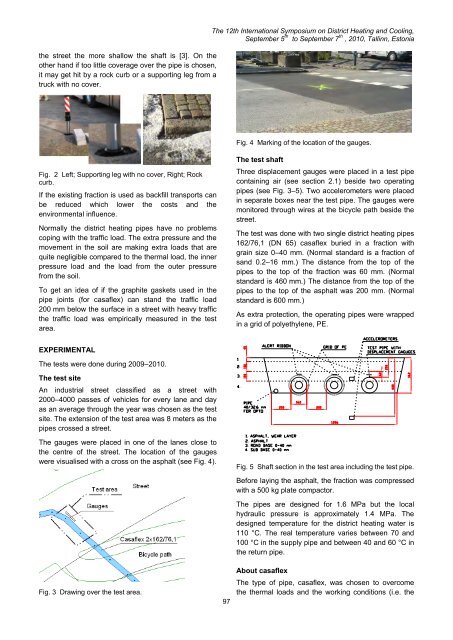12th International Symposium on District Heating and Cooling
12th International Symposium on District Heating and Cooling
12th International Symposium on District Heating and Cooling
You also want an ePaper? Increase the reach of your titles
YUMPU automatically turns print PDFs into web optimized ePapers that Google loves.
the street the more shallow the shaft is [3]. On theother h<strong>and</strong> if too little coverage over the pipe is chosen,it may get hit by a rock curb or a supporting leg from atruck with no cover.The <str<strong>on</strong>g>12th</str<strong>on</strong>g> <str<strong>on</strong>g>Internati<strong>on</strong>al</str<strong>on</strong>g> <str<strong>on</strong>g>Symposium</str<strong>on</strong>g> <strong>on</strong> <strong>District</strong> <strong>Heating</strong> <strong>and</strong> <strong>Cooling</strong>,September 5 th to September 7 th , 2010, Tallinn, Est<strong>on</strong>iaFig. 4 Marking of the locati<strong>on</strong> of the gauges.Fig. 2 Left; Supporting leg with no cover, Right; Rockcurb.If the existing fracti<strong>on</strong> is used as backfill transports canbe reduced which lower the costs <strong>and</strong> theenvir<strong>on</strong>mental influence.Normally the district heating pipes have no problemscoping with the traffic load. The extra pressure <strong>and</strong> themovement in the soil are making extra loads that arequite negligible compared to the thermal load, the innerpressure load <strong>and</strong> the load from the outer pressurefrom the soil.To get an idea of if the graphite gaskets used in thepipe joints (for casaflex) can st<strong>and</strong> the traffic load200 mm below the surface in a street with heavy trafficthe traffic load was empirically measured in the testarea.The test shaftThree displacement gauges were placed in a test pipec<strong>on</strong>taining air (see secti<strong>on</strong> 2.1) beside two operatingpipes (see Fig. 3–5). Two accelerometers were placedin separate boxes near the test pipe. The gauges werem<strong>on</strong>itored through wires at the bicycle path beside thestreet.The test was d<strong>on</strong>e with two single district heating pipes162/76,1 (DN 65) casaflex buried in a fracti<strong>on</strong> withgrain size 0–40 mm. (Normal st<strong>and</strong>ard is a fracti<strong>on</strong> ofs<strong>and</strong> 0.2–16 mm.) The distance from the top of thepipes to the top of the fracti<strong>on</strong> was 60 mm. (Normalst<strong>and</strong>ard is 460 mm.) The distance from the top of thepipes to the top of the asphalt was 200 mm. (Normalst<strong>and</strong>ard is 600 mm.)As extra protecti<strong>on</strong>, the operating pipes were wrappedin a grid of polyethylene, PE.EXPERIMENTALThe tests were d<strong>on</strong>e during 2009–2010.The test siteAn industrial street classified as a street with2000–4000 passes of vehicles for every lane <strong>and</strong> dayas an average through the year was chosen as the testsite. The extensi<strong>on</strong> of the test area was 8 meters as thepipes crossed a street.The gauges were placed in <strong>on</strong>e of the lanes close tothe centre of the street. The locati<strong>on</strong> of the gaugeswere visualised with a cross <strong>on</strong> the asphalt (see Fig. 4).Fig. 5 Shaft secti<strong>on</strong> in the test area including the test pipe.Before laying the asphalt, the fracti<strong>on</strong> was compressedwith a 500 kg plate compactor.The pipes are designed for 1.6 MPa but the localhydraulic pressure is approximately 1.4 MPa. Thedesigned temperature for the district heating water is110 °C. The real temperature varies between 70 <strong>and</strong>100 °C in the supply pipe <strong>and</strong> between 40 <strong>and</strong> 60 °C inthe return pipe.Fig. 3 Drawing over the test area.97About casaflexThe type of pipe, casaflex, was chosen to overcomethe thermal loads <strong>and</strong> the working c<strong>on</strong>diti<strong>on</strong>s (i.e. the
















